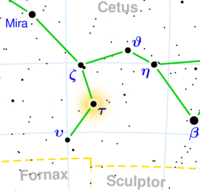Tau Ceti
 From Conservapedia
From Conservapedia | Tau Ceti | |
|---|---|

| |
| Observational Data | |
| Designation | Tau Ceti HD 10700 |
| Right ascension | 01h 44m 04.0829s |
| Declination | −15o 56′ 14.928″ |
| Constellation | Cetus |
| Type of object | Star |
| Magnitude | Apparent Mag: 3.50 Absolute Mag: 5.69 |
| Astrometry | |
| Distance from Earth | 11.9 ly |
| Radial velocity | −16.4 km/s |
| Proper motion | RA: −1721.94 mas/yr Dec.: 854.17 mas/yr |
| Parallax | 273.96 ± 0.17 mas |
Tau Ceti is a star similar in spectral type and mass to our sun located 11.9 light years away in the south central part of Constellation Cetus. The similarities to our own star have lead to widespread interest in the star in both astronomy and Science Fiction over the decades. Interest in Tau Ceti has recently increased due to the large, dense debris disk discovered around the star in 2004.
Contents
- 1 The Star
- 2 Dust Disk
- 3 Search for Substellar Companions
- 4 References
The Star[edit]
Tau Ceti has an apparent magnitude of 3.50,[1] allowing it to be easily seen in the night sky, in fact from a hypothetical planet around Tau Ceti, our sun being a similar G class star, would appear as a star of similar magnitude in the night sky. Tau Ceti is the second closest class G star to us, with only Alpha Centauri A being closer, leading to much speculation and fiction about extraterrestrial life in the system.
Most of what we learned about the physical properties of Tau Ceti has been determined through spectroscopic measurements. The star is a yellow-orange, main sequence star of spectral type G8 V,[1] though Tau Ceti is both smaller and less massive then our sun, with around 81 to 82 percent of the mass, and around 77 percent of the diameter of Sol (our sun).[2] The star is also significantly dimmer with only 59 percent of the luminosity of our star.[3]
Tau Ceti has a much lower metallicity in comparison to stars similar to our sun. Recent measurements show that Tau Ceti has only one-third of our sun’s abundance of iron. Past measurements have produced a metallicity of 22 to 74 percent of Sol’s.[4]
The star's surface also appears inactive, showing a much weaker sunspot cycle then our own Sun.
Dust Disk[edit]
On July 6, 2004 a team of British astronomers using the Submillimetre Common-User Bolometer Array (SCUBA) of the James Clerk Maxwell Telescope in Hawaii announced they had found a debris disk ten times the mass of the debris (such as comets and asteroids) found in our own Solar System. The debris disk extends as far out as 55 AUs from the star and is believed created by collisions between comets and asteroids over time into smaller and smaller, more numerous pieces.[5] The total mass of the debris field is estimated to be 1.2 times the mass of the Earth based on modelling of the dust disk observations. In comparison, the debris of asteroids and comets in the Kuiper Belt only add up to 10% of the mass of Earth.[5]
Search for Substellar Companions[edit]
Thus far no large substellar companions such as a gas giant or a brown dwarf have been found around Tau Ceti, however the search was for such worlds that orbit very close to the star.[6]
The habitable zone where any Earth-like terrestrial worlds where liquid water could exist is centered around 0.68 AUs, or approximately the distance of Venus from the Sun.[7] There is debate if such worlds could support complex life given the likelihood of heavy, frequent bombardment from Tau Ceti’s dense debris disk. Others astronomers argue that a giant planet in the outer system could deflect comets and asteroids away from any world that may support life, much like Jupiter does for Earth.
Astronomers are hoping to use NASA's Terrestrial Planet Finder (TPF) and the ESA's Darwin to search for substellar companions, including smaller, terrestrial worlds.
References[edit]
- ↑ 1.0 1.1 http://simbad.u-strasbg.fr/simbad/sim-basic?Ident=tau+ceti
- ↑ http://adsabs.harvard.edu/cgi-bin/nph-bib_query?bibcode=2003A&A...406L..15P&db_key=AST&high=40d31b5ca015926
- ↑ http://adsbit.harvard.edu/cgi-bin/nph-iarticle_query?1996ApJ...460..993S
- ↑ http://adsbit.harvard.edu/cgi-bin/nph-iarticle_query?bibcode=1992A&AS...95..273C
- ↑ 5.0 5.1 http://adsabs.harvard.edu/abs/2004MNRAS.351L..54G
- ↑ http://adsabs.harvard.edu/cgi-bin/nph-bib_query?bibcode=2000AJ....119..906S&db_key=AST&high=38e0b7728711330
- ↑ http://www.exoplaneten.de/tauceti/english.html
Categories: [Astronomy]
↧ Download as ZWI file | Last modified: 02/18/2023 20:29:28 | 8 views
☰ Source: https://www.conservapedia.com/Tau_Ceti | License: CC BY-SA 3.0
 ZWI signed:
ZWI signed: KSF
KSF